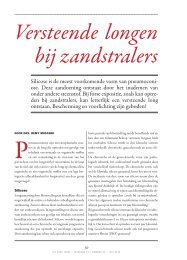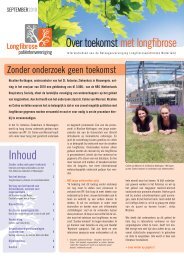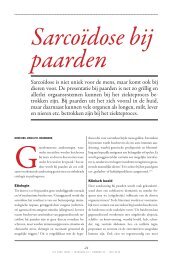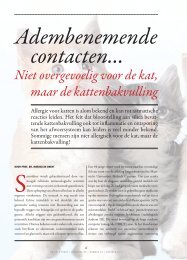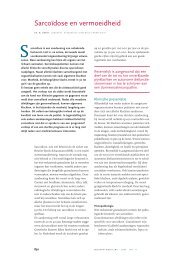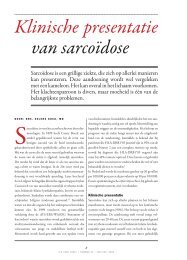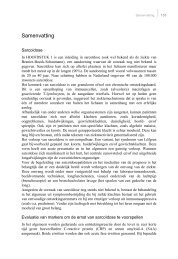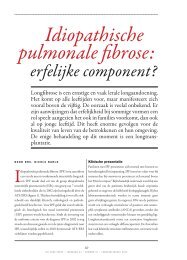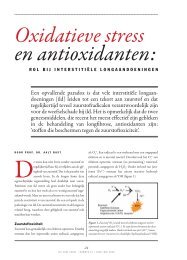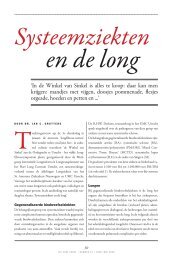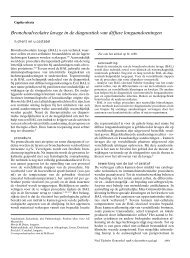Interpretation of bronchoalveolar lavage fluid cytology - ILD care
Interpretation of bronchoalveolar lavage fluid cytology - ILD care
Interpretation of bronchoalveolar lavage fluid cytology - ILD care
Create successful ePaper yourself
Turn your PDF publications into a flip-book with our unique Google optimized e-Paper software.
Bronchoalveolar <strong>lavage</strong><br />
Marjolein Drent<br />
Jan A. Jacobs<br />
Sjoerd Sc. Wagenaar<br />
<strong>Interpretation</strong> <strong>of</strong> BALF <strong>cytology</strong><br />
Summary<br />
Bronchoalveolar <strong>lavage</strong> readily explores large areas <strong>of</strong> the alveolar compartment. After the introduction as a<br />
research tool, <strong>bronchoalveolar</strong> <strong>lavage</strong> has been appreciated extensively for clinical applications in the field <strong>of</strong><br />
opportunistic infections and interstitial lung diseases. It is considered as a safe, minimally invasive procedure,<br />
associated with virtually no morbidity. In selected cases, <strong>bronchoalveolar</strong> <strong>lavage</strong> is useful for establishing or ruling<br />
out a diagnosis with only a low risk <strong>of</strong> in correct diagnosis. In contrast, the role <strong>of</strong> <strong>bronchoalveolar</strong> <strong>lavage</strong> in the<br />
management and prediction <strong>of</strong> the prognosis <strong>of</strong> a certain disorder is, so far, rather controversial. The potential<br />
practical value <strong>of</strong> BAL in the diagnosis <strong>of</strong> diffuse interstitial lung diseases will be discussed.<br />
Eur Respir Mon 2000;14: 63-78.<br />
Introduction<br />
Diffuse interstitial lung disease (D<strong>ILD</strong>) poses a significant challenge for the clinician because the aetiology is <strong>of</strong>ten<br />
unknown. To establish the diagnosis, a thorough history is essential as it may identify a potential aetiological factor<br />
(e.g. drug reaction, subtle or prolonged environmental and/or occupational exposures). Pulmonary diseases have<br />
traditionally been evaluated by laboratory tests, lung function tests, imaging procedures and tissue biopsies [1-3].<br />
Bronchoalveolar <strong>lavage</strong> (BAL) represents an additional tool in assessing the health status <strong>of</strong> the lung. BAL is a<br />
procedure in which the <strong>bronchoalveolar</strong> region <strong>of</strong> the respiratory tract is <strong>lavage</strong>d or washed with an isotonic salt<br />
solution. It is a method for sampling cells and solutes from a large area deep within the tissue <strong>of</strong> the lung. BAL has<br />
emerged to be useful both in fundamental research and for clinical purposes [4-9]. Clinically, this procedure was first<br />
used at Yale in 1922 as a therapeutic tool, e.g. in the management <strong>of</strong> phosgene poisoning and as a means <strong>of</strong><br />
removing abundant secretions [4]. Gradually, BAL became more widely applied in the treatment <strong>of</strong> various<br />
pulmonary disorders, such as cystic fibrosis, alveolar microlithiasis, alveolar proteinosis and lipoid pneumonia [4-10].<br />
The application <strong>of</strong> BAL for diagnostic purposes has significantly improved the diagnostic work-up <strong>of</strong> D<strong>ILD</strong> [4-14]. It<br />
is broadly indicated in patients with diffuse chest radiograph abnormalities, whatever the suspected cause. The<br />
underlying disorders may be <strong>of</strong> infectious, noninfectious immunological, malignant, environmental or occupational<br />
aetiology. Even in conditions in which <strong>lavage</strong> is not diagnostic, the results may be inconsistent with the suspected<br />
diagnosis, and then focus attention on more appropriate, further investigations. For example, even a normal <strong>lavage</strong><br />
may be useful to exclude some disorders with high probability.<br />
Furthermore, BAL has the potential to be useful in the assessment <strong>of</strong> disease activity, in determining prognosis [15],<br />
and in guiding therapy. These are, however, the most critically discussed topics in the field <strong>of</strong> BAL [9, 11, 15-18].<br />
Bronchoalveolar <strong>lavage</strong> procedure<br />
The BAL technique is not completely standardized. Details <strong>of</strong> the different steps <strong>of</strong> the procedure used may vary a<br />
great deal between laboratories. Sometimes these differences give rise to problems when comparing data. Attempts<br />
have been made to set up a frame-work for the different steps <strong>of</strong> the procedure, such as the amount and<br />
temperature <strong>of</strong> <strong>fluid</strong> injected, the number <strong>of</strong> aliquots used, the “dwelling time” and the aspiration pressure. Guidelines<br />
and recommendations for using a standardized approach regarding the procedure as well as processing the material<br />
have been published [5, 7, 8, 13, 19].<br />
In general, after local anaesthesia <strong>of</strong> the larynx and bronchial tree with lidocaine to control cough, BAL can be<br />
performed through a bronchoscope transnasally, transorally, or through an in-place tube. After a complete inspection<br />
<strong>of</strong> the airways, a fibreoptic bronchoscope is gently impacted, or “wedged”, into a segmental or subsegmental<br />
bronchus [7, 13]. From an anatomical point <strong>of</strong> view, either the middle lobe or lingula is most convenient to access,<br />
and, therefore routinely used [13, 19]. From these lobes, 20% or more <strong>fluid</strong> and cells are recovered compared to<br />
the lower lobes. The basic goal is to ensure that the injected <strong>fluid</strong> reaches the appropriate pathological area. In<br />
addition, the aspirate has to be a representative sample containing solutes and cells obtained from the lower<br />
respiratory tract, reflecting the pathophysiological process <strong>of</strong> the disease. In general, results obtained at one site<br />
are representative for the whole lung especially, in D<strong>ILD</strong>, <strong>lavage</strong>s <strong>of</strong> separate segments yielded similar results.<br />
However, in localized disease such as inflammatory infiltrates and malignant lesions, <strong>lavage</strong> at different sites may<br />
provide different results [13]. In these localized disorders, it is recommended that the area <strong>of</strong> greatest abnormality,<br />
demonstrated on the chest radiograph or high resolution computed tomography (HRCT) scan, be chosen as an<br />
appropriate segment for BAL [13].<br />
The most commonly used <strong>lavage</strong> solution is sterile isotonic saline, prewarmed to body temperature. The <strong>fluid</strong> is<br />
instilled into the subsegment through the biopsy channel <strong>of</strong> the bronchoscope and, subsequently, immediately<br />
aspirated and recovered. Aspiration should be performed by applying gentle suction. Suction which is too forceful<br />
can cause collapse <strong>of</strong> the distal airways or trauma <strong>of</strong> the airway mucosa, and so alter the BAL <strong>fluid</strong> (BALF) pr<strong>of</strong>ile<br />
Bronchoalveolar <strong>lavage</strong>. Drent et al. Eur Respir Mon 2000. 1



